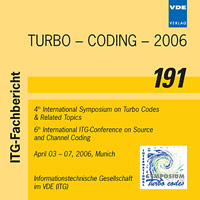A Method for Lowering Turbo Code Error Flare using Correction Impulses and Repeated Decoding
Konferenz: TURBO - CODING - 2006 - 4th International Symposium on Turbo Codes & Related Topics; 6th International ITG-Conference on Source and Channel Coding
03.04.2006 - 07.04.2006 in Munich, Germany
Tagungsband: TURBO - CODING - 2006
Seiten: 6Sprache: EnglischTyp: PDF
Persönliche VDE-Mitglieder erhalten auf diesen Artikel 10% Rabatt
Autoren:
Ould-Cheikh-Mouhamedou, Youssouf; Kabal, Peter (Electrical and Computer Engineering, McGill University, Montreal, Canada)
Crozier, Stewart; Gracie, Ken; Guinand, Paul (Communications Research Centre, Ottawa, Canada)
Inhalt:
Turbo codes exhibit an “error floor” or “flare” making it difficult to further improve the error performance without a significant increase in the signal-to-noise ratio (SNR). The error flare is mainly characterized by the distance properties of the code. The conventional way to lower the error flare is to increase the minimum distance, which is mainly determined by the interleaver. Unfortunately, the design of interleavers that yield high minimum distances is not a simple task. In fact, the design of such interleavers for applications requiring very low frame error rates (FERs) can be a real challenge. This paper introduces a new method that significantly lowers the error flare while leaving the interleaver unchanged. It also improves the error performance in the waterfall region. The key element of this method is the insertion of correction impulses in the received codeword and the use of repeated decoding. The effectiveness of this method is demonstrated by its ability to reduce the error rate by one order of magnitude in the waterfall region and more than three orders of magnitude in the flare region for 8-state single- and double-binary turbo codes of code rate 1/3 and 1/2 that use high-spread random (HSR) interleavers and packets of 1504 bits.


